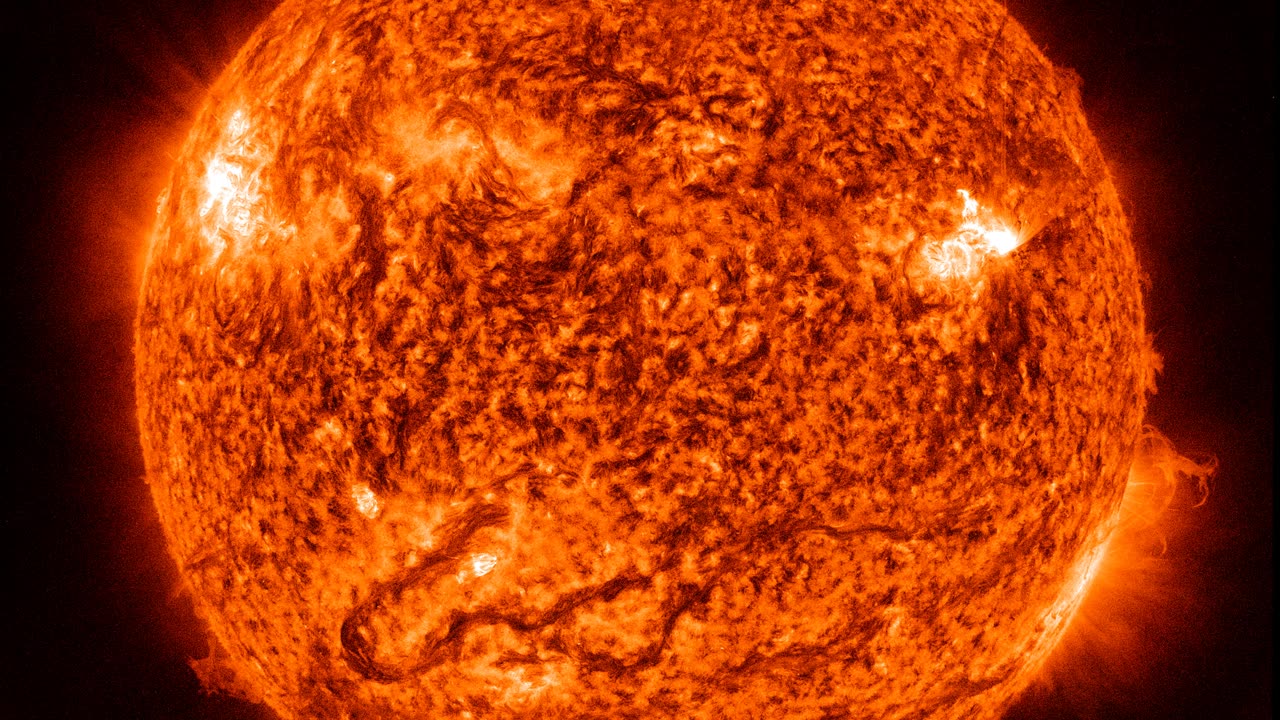Premium Only Content

Solar X-Flare - October 2, 2022 (X1.0 class)
Solar Dynamics Observatory (SDO) operates in a geosynchronous orbit around Earth to obtain a continuous view of the Sun. The particular instrument in this visualization records imagery in the ultraviolet portion of the spectrum at wavelengths normally absorbed by Earth's atmosphere - so we need to observe them from space.
The solar flare as seen in AIA 171 Angstrom filter. Correction is applied for the instrument Point-Spread Function (PSF).
Here we have multi-wavelength views of an X1.0 class flare from early October 2022 (upper right of image). Solar flares are classified by the amount of energy released (Solar Flares: What Does It Take to Be X-Class?). Several long filaments or prominences (the dark ribbons) meander across the lower hemisphere.
What is the PSF (Point Spread-Function)?
Many telescopes, especially reflecting telescopes such as the ones used on SDO (Wikipedia), have internal structures that support various optical components. These components can result in incoming light being scattered to other parts of the image. This can appear in the image as a faint haze, brightening dark areas and dimming bright areas. The point-spread function (Wikipedia) is a measure of how light that would normally be received by a single camera pixel, gets scattered onto other pixels. This is often seen as the "spikes" seen in images of bright stars. For SDO, it manifests as a double-X shape centered over a bright flare (see Sun Emits Third Solar Flare in Two Days). The effect of this scattered light can be computed, and removed, by a process called deconvolution (Wikipedia). This is often a very compute-intensive process which can be sped up by using a computers graphics-processing unit (GPU) for the computation. This video is public domain and along with other supporting visualizations can be downloaded from the Scientific Visualization Studio at: http://svs.gsfc.nasa.gov/13425 NASA's Scientific Visualization Studio/Scott Wiessinger If you liked this video, subscribe to the NASA Goddard YouTube channel: http://www.youtube.com/NASAExplorer Follow NASA’s Goddard Space Flight Center • Instagram http://www.instagram.com/nasagoddard • Twitter http://twitter.com/NASAGoddard • Twitter http://twitter.com/NASAGoddardPix • Facebook: http://www.facebook.com/NASA.GSFC • Flickr http://www.flickr.com/photos/gsfc
-
 LIVE
LIVE
The Jimmy Dore Show
2 hours agoJohn Bolton Staring At LIFE IN PRISON! Kash Patel Pushes PURE BS Line About Kirk Assassination!
8,627 watching -
 LIVE
LIVE
Nerdrotic
3 hours ago $10.05 earnedRacist Academics Attack Tolkien | Hollywood to Strike AGAIN? | AI Doomsday - Friday Night Tights 376
2,426 watching -
 9:32:02
9:32:02
Dr Disrespect
10 hours ago🔴LIVE - DR DISRESPECT - ARC RAIDERS - THE ULTRA EXTRACTION GAME
143K10 -
 27:49
27:49
Robbi On The Record
21 hours ago $5.34 earnedRevelation, the End Times, and Satan’s Little Season part II - ft JT
25K6 -
 54:37
54:37
HotZone
4 days ago $1.64 earnedTen Hostages Missing! Will Hamas Keep Its Word?
27.1K4 -
 8:05
8:05
Rethinking the Dollar
8 hours agoFiat’s Endgame? Gold & Silver Lines Don't Lie
14.7K6 -
 LIVE
LIVE
LFA TV
23 hours agoLIVE & BREAKING NEWS! | FRIDAY 10/17/25
919 watching -
 1:13:16
1:13:16
vivafrei
5 hours agoJohn Bolton is a DUMB CRIMINAL (Allegedly) - Trans Madness in Loudoun Country! Tampon Tim AND MORE!
89K42 -
 2:45:30
2:45:30
Barry Cunningham
17 hours agoBREAKING NEWS! PRESIDENT TRUMP MEETS WITH UKRAINE PRESIDENT ZELENSKY!
69K28 -
![MAHA News [10.17] Fertility Crisis, Redoing Vax Schedule, Psychiatry Corruption, Vegan vs Carnivore](https://1a-1791.com/video/fwe2/78/s8/1/Q/v/s/r/Qvsrz.0kob-small-MAHA-News-10.17.jpg) 1:19:44
1:19:44
Badlands Media
16 hours agoMAHA News [10.17] Fertility Crisis, Redoing Vax Schedule, Psychiatry Corruption, Vegan vs Carnivore
29K3